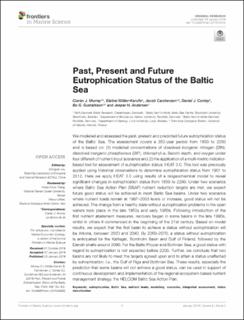| dc.description.abstract | We modelled and assessed the past, present and predicted future eutrophication status of the Baltic Sea. The assessment covers a 350-year period from 1850 to 2200 and is based on: (1) modelled concentrations of dissolved inorganic nitrogen (DIN), dissolved inorganic phosphorous (DIP), chlorophyll-a, Secchi depth, and oxygen under four different of nutrient input scenarios and (2) the application of a multi-metric indicator-based tool for assessment of eutrophication status: HEAT 3.0. This tool was previously applied using historical observations to determine eutrophication status from 1901 to 2012. Here we apply HEAT 3.0 using results of a biogeochemical model to reveal significant changes in eutrophication status from 1850 to 2200. Under two scenarios where Baltic Sea Action Plan (BSAP) nutrient reduction targets are met, we expect future good status will be achieved in most Baltic Sea basins. Under two scenarios where nutrient loads remain at 1997–2003 levels or increase, good status will not be achieved. The change from a healthy state without eutrophication problems in the open waters took place in the late 1950s and early 1960s. Following introduction of the first nutrient abatement measures, recovery began in some basins in the late 1990s, whilst in others it commenced in the beginning of the 21st century. Based on model results, we expect that the first basin to achieve a status without eutrophication will be Arkona, between 2030 and 2040. By 2060–2070, a status without eutrophication is anticipated for the Kattegat, Bornholm Basin and Gulf of Finland, followed by the Danish straits around 2090. For the Baltic Proper and Bothnian Sea, a good status with regard to eutrophication is not expected before 2200. Further, we conclude that two basins are not likely to meet the targets agreed upon and to attain a status unaffected by eutrophication, i.e., the Gulf of Riga and Bothnian Bay. These results, especially the prediction that some basins will not achieve a good status, can be used in support of continuous development and implementation of the regional ecosystem-based nutrient management strategy, the HELCOM Baltic Sea Action Plan. | en_US |

